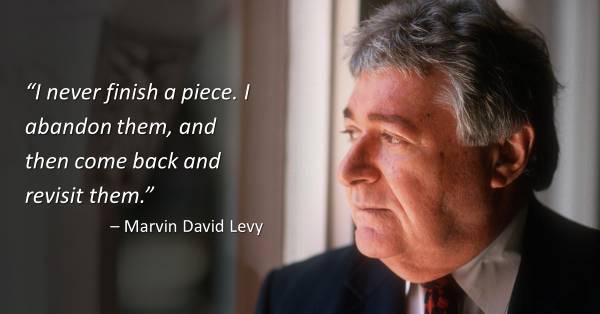Rediscover Marvin David Levy: Lifelong Apprentice

August 07, 2019
That Marvin David Levy (1932–2015) once described composing as a “lifetime apprenticeship” reflects the reality that he was rarely satisfied with his work and subjected it to constant revision. His works were premiered and then withdrawn, many of them reworked and rereleased years or even decades later. So it is perhaps fitting that the cyclic manner of his career and the dramatic nature of his music mirrored his life. A New York Times obituary aptly compared Levy’s life trajectory to that of his most famous work, the opera Mourning Becomes Electra: “Its history — from highly touted prospect to object of obscurity to recipient of late-life acclaim — parallels his own.”
Levy’s rise culminated in the commissioning of Mourning Becomes Electra by the Metropolitan Opera in 1967. But the reviews were not kind, and the event precipitated a sharp decline. As commissions dried up, Levy turned to teaching and eventually became caught up in legal troubles that landed him in prison in the early 1980s. There, he began composing again, or— more accurately — recomposing. But he unshackled himself from the cerebral, atonal style in which he had been reared and embraced a lyrical style that came more naturally. He revived several works and received considerable acclaim.
Among Levy’s oeuvre are two Jewish-themed secular works and a complete sacred service for the Sabbath eve, all of which received world premiere recordings by the Milken Archive.
Tisha b’av, which begins this Saturday and marks the destruction of the Second Temple in 70 CE, also coincides with the generally accepted date of the 1492 expulsion edict and the attempted eradication of Spanish Jewry. Beginning in 1492 (though there were earlier precedents), the Spanish monarchy ordered all Jews within the Iberian Peninsula to convert to Catholicism or be expelled. That expulsion decree, which was only formally rescinded in 1968, set off a cavalcade of migration and resulted in the creation of a new class of Jews who formally converted to Catholicism but continued to observe Judaic religious practice in secret: marranos, or crypto-Jews.
Short documentary of Marvin David Levy's Canto de los marranos.
Marvin David Levy’s cantata, Canto de los Marranos, tells the story of the crypto-Jews who remained in Spain after the Inquisition and were caught between two faiths—the Catholicism to which they had been forcibly converted, and the Judaism they observed in secret. Levy reflects this tension both musically and textually, the latter through juxtaposing the Catholic credo and the Judaic sh’ma. The recording features famed soprano Ana Maria Martinez.
The imposing plateau that rises above the Dead Sea in the south of Israel provides the setting of a second cantata, Masada. Yet, as Neil Levin has noted, at the time Masada was commissioned by the National Symphony Orchestra, Levy was, like most American Jews, unfamiliar with the fortress. However, he had seen an archeological exhibition on the site and perceived the story’s musical-dramatic possibilities. Research led him to the 1927 epic Hebrew poem by Yitzḥak Lamdan, which forms much of the work’s text and overall narrative, and has been credited with helping to imbue the monument with its contemporary symbolic significance.
Marvin David Levy's Masada
Scored for full orchestra and tenor, Masada received its premiere in 1973 at the Kennedy Center in Washington, D.C., with Richard Tucker in the tenor role. Masada later became Levy’s first post-incarceration premiere when a revised version of the work was presented in Chicago in 1987. For the Milken Archive recording, Levy revised the piece yet again, shortening it and omitting a speaking part, as well as adding new musical and textual material.
A Foray into Liturgical Music
In the world of synagogue music, few names loom as large as Cantor David Putterman. Beginning in 1943, Putterman initiated a commissioning program at New York’s Park Avenue Synagogue that generated liturgical settings and complete sacred services by leading American and European émigré composers, and held premiere concert-services that were major events on the city’s cultural calendar. Levy was commissioned for the program in 1964 and produced Shir Shel Moshe—a complete setting of kabbalat shabbat (welcoming the Sabbath) and Sabbath eve liturgies as a musically complete, unified service for organ, chorus, and cantor (learn more about the work in an interview). It was the only liturgical work Levy ever composed. In his review of the work after its premiere, Erwin Jospe, an experienced composer of synagogue music, noted Levy’s personal approach to the work:
He is not pretending to be somebody other than himself when he writes for the synagogue. There is nothing assumed, nothing pseudo-Jewish . . . . He simply approaches his task as a composer . . . who uses musical ideas—and he has many—to build musical structures.
Tragic as Levy’s fall from grace was, it imbued him with a renewed passion for music and a galvanized sense of artistic purpose. Yet he never got past his impulse to revise. “I never finish a piece,” he remarked in a 1998 interview with the Milken Archive. “I abandon them, and then come back and revisit them.”
